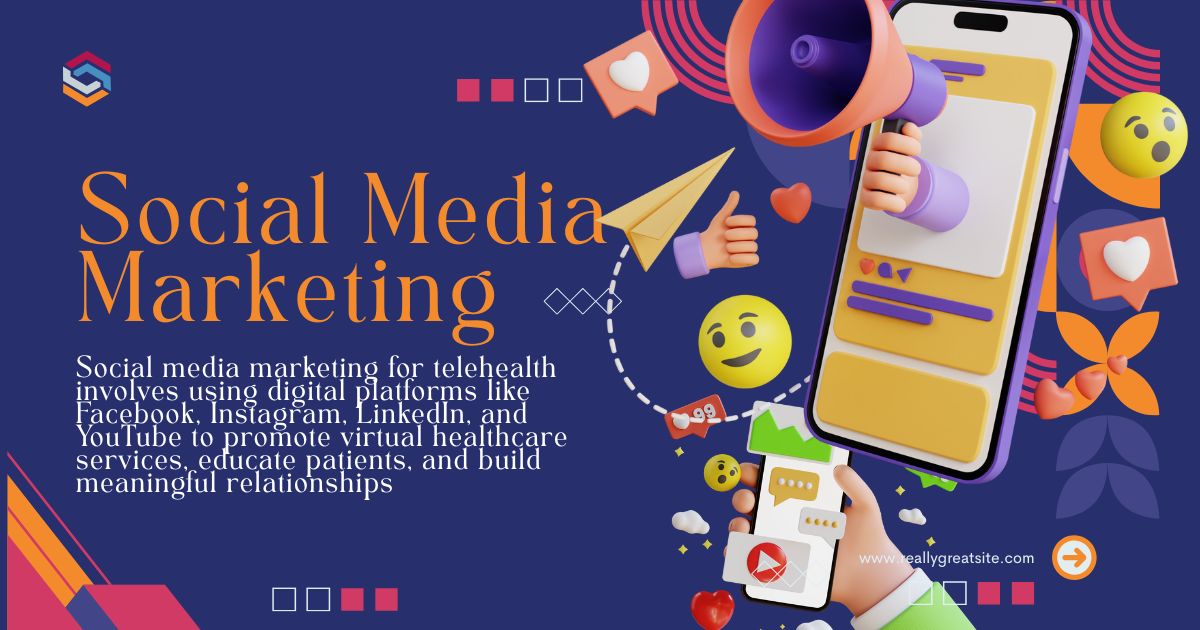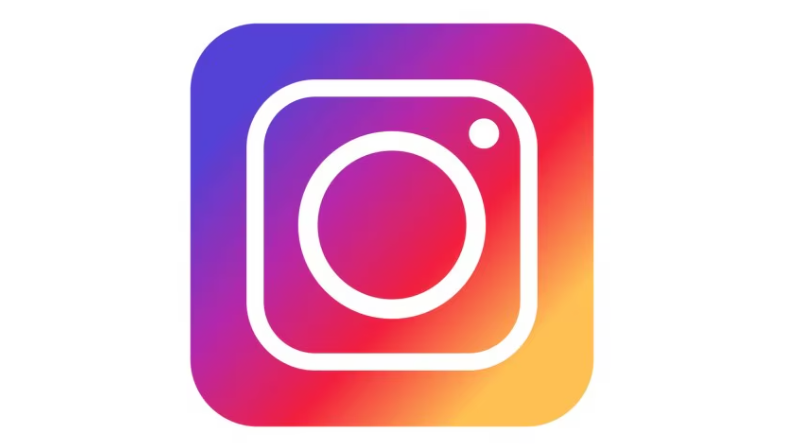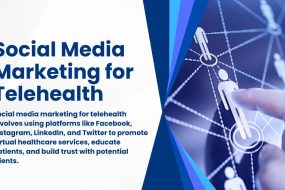
The healthcare industry has experienced unprecedented digital transformation, with telehealth services growing by over 3,800% during the pandemic according to McKinsey research. As virtual care becomes mainstream, healthcare providers face new challenges in reaching patients through digital channels. Social media marketing for telehealth represents a powerful solution for connecting with patients, building trust, and expanding access to care.
Social media marketing for telehealth involves using digital platforms like Facebook, Instagram, LinkedIn, and YouTube to promote virtual healthcare services, educate patients, and build meaningful relationships with communities. Unlike traditional healthcare marketing, telehealth social media strategies must address unique concerns around privacy, credibility, and the virtual nature of care delivery.
This comprehensive guide explores how healthcare providers can leverage social media to grow their telehealth practice while maintaining compliance and building patient trust in virtual care environments.
Understanding Telehealth Social Media Marketing
Social media marketing for telehealth differs significantly from traditional healthcare marketing approaches. While conventional medical marketing might focus on physical locations and in-person services, telehealth marketing platforms emphasizes accessibility, convenience, and the quality of virtual care experiences.
The primary goal extends beyond simple appointment booking. Effective telehealth social media marketing educates potential patients about virtual care benefits, addresses common concerns about remote consultations, and demonstrates the technology’s ease of use. This educational component becomes crucial since many patients still feel uncertain about receiving healthcare through digital platforms.
Healthcare providers must also navigate complex regulatory requirements when marketing telehealth services on social media. HIPAA compliance, state licensing restrictions, and platform-specific advertising policies create additional layers of consideration that don’t exist with traditional marketing methods.
Key Benefits of Social Media for Telehealth Providers
Expanding Patient Reach Beyond Geographic Boundaries
Traditional healthcare marketing targets local communities within driving distance of physical facilities. Social media marketing for telehealth can reach patients across entire states or regions, depending on licensing agreements. This expanded reach proves particularly valuable for specialized services where local expertise may be limited.
Rural patients who previously traveled hours for specialist consultations can discover telehealth options through targeted social media campaigns. Mental health providers, dermatologists, and other specialists can serve broader populations by effectively communicating their virtual care capabilities through social platforms.
Building Trust Through Transparency
Virtual healthcare relationships require higher levels of trust since patients cannot rely on physical presence and facility appearance to assess credibility. Social media provides powerful tools for building this trust through consistent, transparent communication.
Healthcare providers can share behind-the-scenes content showing their actual offices, introduce team members through video content, and display credentials prominently across social profiles. Patient testimonials and success stories help prospective patients understand what to expect from virtual consultations.
Cost-Effective Patient Acquisition
Compared to traditional healthcare marketing methods like print advertising or direct mail, social media marketing offers superior cost-effectiveness and targeting precision. Healthcare providers can reach specific demographics, geographic areas, and even individuals with particular health interests at fraction of traditional advertising costs.
Facebook and Instagram ads allow telehealth providers to target users who have shown interest in health and wellness content marketing, live in specific zip codes, or fall within certain age ranges most likely to need their services. This precision targeting reduces wasted ad spend on unqualified audiences.
Real-Time Patient Education and Support
Social media platforms enable healthcare providers to share timely health information, address common questions, and provide ongoing support between appointments. This continuous engagement helps maintain patient relationships and positions providers as trusted health resources.
During flu season, telehealth providers can share prevention tips and promote virtual consultations for early symptom assessment. Mental health providers can post daily wellness tips and stress management techniques that support their patients’ ongoing care.
Essential Social Media Platforms for Telehealth
Facebook: Community Building and Detailed Targeting

Facebook remains the most versatile platform for telehealth marketing due to its sophisticated advertising capabilities and diverse user demographics. Healthcare providers can create business pages, share educational content, and run highly targeted advertising campaigns.
Facebook Groups provide opportunities to build communities around specific health conditions or wellness topics. A diabetes management telehealth service might create a support group where patients share experiences, ask questions, and receive ongoing education from healthcare professionals.
The platform’s detailed targeting options allow providers to reach users based on demographics, interests, behaviors, and even life events. A maternal health telehealth service can target expectant mothers within specific geographic areas, while mental health providers can reach individuals who have shown interest in stress management or anxiety resources.
Instagram: Visual Health Education and Behind-the-Scenes Content

Instagram’s visual format excels at making healthcare content more approachable and engaging. Healthcare providers can use photos, videos, and Stories to humanize their practice and demonstrate the simplicity of telehealth technology.
Before-and-after photos work well for dermatology telehealth services, while mental health providers might share inspirational quotes, self-care tips, and brief educational videos. Instagram Stories allow for real-time updates, quick polls to gauge patient interests, and direct communication through private messages.
The platform’s younger demographic makes it particularly valuable for pediatric telehealth services or providers targeting millennials and Gen Z patients who are typically more comfortable with digital healthcare solutions.
LinkedIn: Professional Networking and B2B Opportunities

LinkedIn serves as the primary platform for reaching other healthcare professionals, potential business partners, and employers who might offer telehealth services as employee benefits. Healthcare providers can establish thought leadership through articles, participate in industry discussions, and network with colleagues.
Telehealth providers can use LinkedIn to connect with primary care physicians who might refer patients for specialized virtual consultations. Mental health professionals can network with employee assistance program administrators and human resources professionals who oversee workplace wellness initiatives.
YouTube: Long-Form Educational Content and Technology Demonstrations

YouTube’s long-form video format provides ideal opportunities for comprehensive patient education and technology demonstrations. Healthcare providers can create detailed explanations of conditions, treatment options, and step-by-step guides for using telehealth platforms.
A telehealth dermatology practice might create videos showing how to properly photograph skin conditions for virtual consultations, while mental health providers can offer guided meditation sessions or coping strategy tutorials. These educational videos establish expertise while addressing common patient concerns about virtual care quality.
Creating Effective Telehealth Social Media Content
Educational Content That Addresses Virtual Care Concerns
Successful telehealth social media marketing prioritizes education over direct promotion. Patients need to understand how virtual consultations work, what technology they’ll need, and what types of conditions can be effectively treated through telehealth platforms.
Create content that walks patients through the entire telehealth experience, from scheduling appointments to conducting video calls. Address common concerns about technology requirements, insurance coverage, and the effectiveness of virtual diagnoses compared to in-person visits.
Seasonal health content performs particularly well on social media. Share information about managing seasonal allergies through telehealth, preventing winter depression, or preparing for back-to-school health checkups via virtual consultations.
Patient Success Stories and Testimonials
Patient testimonials provide powerful social proof for telehealth services, helping prospective patients overcome skepticism about virtual care quality. Share stories that highlight specific benefits like convenience, reduced travel time, and positive health outcomes achieved through telehealth.
Focus on diverse patient experiences that represent your target audience demographics. A working parent might emphasize how telehealth enabled them to receive care without missing work or arranging childcare, while an elderly patient might highlight how virtual visits eliminated transportation barriers.
Always obtain proper consent and ensure testimonials comply with HIPAA requirements. Consider using first names only or anonymous testimonials that focus on specific situations rather than identifying information.
Technology Tips and Platform Tutorials
Many patients avoid telehealth services due to technology concerns rather than doubts about care quality. Create content that demystifies the technology and provides step-by-step guidance for using your telehealth platform.
Short video tutorials showing how to download apps, test camera and microphone settings, and troubleshoot common technical issues help patients feel more confident about scheduling virtual appointments. Include content for different devices and operating systems to accommodate various patient preferences.
Share tips for optimizing the telehealth experience, such as choosing well-lit locations for video calls, preparing questions in advance, and having medication lists readily available during consultations.
Read our latest blog Promoting Telehealth Services
Compliance and Privacy Considerations
HIPAA Compliance in Social Media Marketing
Healthcare providers must maintain strict HIPAA compliance when using social media for telehealth marketing. This means never sharing protected health information, avoiding identifiable patient details in testimonials, and being cautious about responding to health-related questions in public forums.
Establish clear social media policies that outline what information can be shared publicly and how staff should handle patient inquiries received through social platforms. Generally, direct patients to private communication channels or phone calls rather than addressing specific health concerns in public comments.
Use generic educational content rather than patient-specific examples when illustrating telehealth benefits. Instead of saying “Patient X improved their diabetes management through our telehealth program,” focus on general benefits like “Telehealth enables more frequent monitoring and adjustment of diabetes management plans.”
State Licensing and Telehealth Regulations
Telehealth regulations vary significantly between states, affecting how providers can market their services across different geographic areas. Some states require special telehealth licenses, while others have specific requirements for patient consent and technology standards.
Research the licensing requirements for each state where you plan to offer telehealth services and ensure your social media marketing complies with local regulations. Avoid making broad geographic claims about service availability without confirming regulatory compliance in those areas.
Include appropriate disclaimers about service availability, licensing limitations, and the need for patients to verify their location during virtual consultations. These disclaimers protect both providers and patients while maintaining transparency about service limitations.
Building Trust and Credibility Online
Showcasing Credentials and Expertise
Virtual healthcare relationships require extra effort to establish credibility since patients cannot rely on physical office environments and face-to-face interactions to assess provider qualifications. Social media profiles should prominently display credentials, certifications, and professional affiliations.
Share content that demonstrates ongoing education and professional development, such as conference attendance, continuing education completion, or new certification achievements. This ongoing learning emphasis helps patients feel confident about receiving cutting-edge care through telehealth platforms.
Consider creating “Meet the Provider” content that introduces your background, specialties, and approach to patient care. Personal touches like hobbies, family life, or community involvement help humanize providers and build stronger patient connections.
Addressing Common Telehealth Misconceptions
Many patients hold misconceptions about telehealth effectiveness, particularly concerns that virtual consultations provide lower-quality care than in-person visits. Create content that addresses these concerns directly with evidence-based information and real-world examples.
Share research studies demonstrating telehealth effectiveness for specific conditions, highlight successful treatment outcomes achieved through virtual care, and explain how technology enables comprehensive assessments for many health concerns.
Address practical concerns like prescription management, follow-up care coordination, and emergency situation handling. Patients need to understand how telehealth providers handle these aspects of care to feel comfortable transitioning from traditional in-person healthcare relationships.
Measuring Social Media Success for Telehealth
Key Performance Indicators
Track metrics that directly relate to telehealth business objectives rather than focusing solely on vanity metrics like followers or likes. Important KPI include appointment bookings generated through social media, cost per patient acquisition, and patient retention rates for socially-acquired patients.
Monitor engagement metrics that indicate genuine interest in telehealth services, such as video completion rates for educational content, click-through rates on appointment booking links, and the quality of questions asked in comments or direct messages.
Track geographic data to understand which locations generate the most social media interest and appointments. This information helps optimize targeting for paid advertising campaigns and identifies opportunities for expanding telehealth services to new markets.
Patient Feedback and Social Listening
Use social listening tools to monitor mentions of your telehealth services across social platforms and review sites. This monitoring helps identify patient satisfaction trends, common concerns, and opportunities for service improvement.
Respond promptly to patient feedback while maintaining HIPAA compliance. Public responses should thank patients for feedback and direct them to private channels for detailed discussions about their care experiences.
Track sentiment analysis over time to understand how patient perceptions of your telehealth services evolve. This data helps identify successful content strategies and areas where additional patient education might be needed.
Maximizing Your Telehealth Social Media Impact
Social media marketing for telehealth requires a strategic approach that balances patient education, trust building, and regulatory compliance. Success depends on understanding your target audience’s concerns about virtual care and addressing those concerns through consistent, valuable content across appropriate platforms.
The most effective telehealth social media strategies focus on education and relationship building rather than direct promotion. By helping patients understand how virtual care works and demonstrating your expertise through helpful content, you create the foundation for long-term patient relationships that extend beyond individual appointments.
Start by choosing one or two social media platforms that align with your target patient demographics and begin sharing educational content consistently. As you build confidence and see results, expand to additional platforms and more sophisticated marketing strategies like paid advertising and community building initiatives.















No Comments